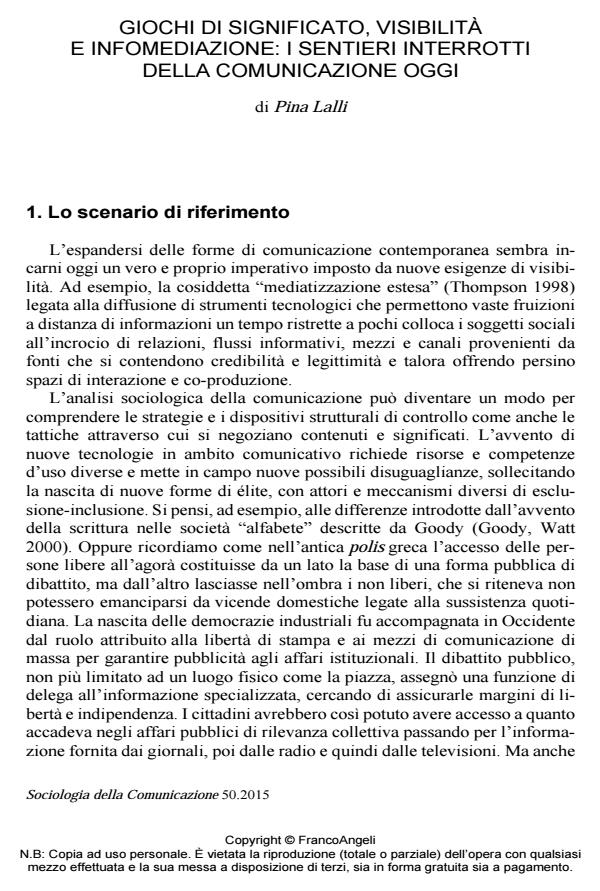Giochi di significato, visibilità e infomediazione: i sentieri interrotti della comunicazione oggi
Titolo Rivista SOCIOLOGIA DELLA COMUNICAZIONE
Autori/Curatori Pina Lalli
Anno di pubblicazione 2016 Fascicolo 2015/50 Lingua Italiano
Numero pagine 11 P. 191-201 Dimensione file 221 KB
DOI 10.3280/SC2015-050018
Il DOI è il codice a barre della proprietà intellettuale: per saperne di più
clicca qui
Qui sotto puoi vedere in anteprima la prima pagina di questo articolo.
Se questo articolo ti interessa, lo puoi acquistare (e scaricare in formato pdf) seguendo le facili indicazioni per acquistare il download credit. Acquista Download Credits per scaricare questo Articolo in formato PDF

FrancoAngeli è membro della Publishers International Linking Association, Inc (PILA)associazione indipendente e non profit per facilitare (attraverso i servizi tecnologici implementati da CrossRef.org) l’accesso degli studiosi ai contenuti digitali nelle pubblicazioni professionali e scientifiche
The article proposes the notion of infomediation as an useful tool for empirical sociological research on the role that new social subjects play today in web communication. After a brief illustration of the contribution of the social sciences for the analysis of the effects and practices of media technologies, especially about the agenda building of the public sphere, the paper describes some examples of the infomediation phenomenon. It assumes from the literature the hypothesis that new technological oligarchic élites are constituting, with strong relationships with other types of élites. Finally, it shows some results and methodological suggestions of a few first empirical researches on the role of Google or Twitter for the newsmaking practices of information.;
- Bazzarin V., Lalli P. (2012), Collective tellers: Web collaboration, two examples, in Multifaceted nature of collaboration in contemporary world, Vega Press Ltd, London, pp. 116-129.
- Boulay S. (2012), Exploration du phénomène d’astroturfing: une stratégie de communication usurpant l’identité citoyenne dans l’espace public, «Communiquer», n. 7, pp. 61-84.
- Bourdieu P (1996), Journalisme et éthique, «Les cahiers du journalisme», 1 (giugno).
- Castells M. (2001), Internet Galaxy, Oxford University Press, Oxford; trad. it. (2006), Galassia Internet, Feltrinelli, Milano.
- Crespi F. (1984), Mediazione simbolica e società, FrancoAngeli, Milano.
- Eysenbach, G. (2008), Medicine 2.0: Social Networking, Collaboration, Participation, Apomediation, and Openness, in «Journal of Medical Internet Research», 10 (3).
- Goody J., Watt, I. (2000), Le conseguenze dell’alfabetizzazione, in P.P. Giglioli, G.
- Fele (a cura di), Linguaggio e contesto sociale, il Mulino, Bologna, pp. 285-331 [1972].
- Habermas J. (1962), Strukturwandel der Öffentlichkeit: Untersuchungen zu einer Kategorie der bürgerlichen Gesellschaft, Luchtrhand, Darmstadt; trad. it. (2005), Storia e critica dell’opinione pubblica, Laterza, Roma-Bari.
- Horkheimer M., Adorno T. W. (1944), Dialektik der Aufklärung. Philosophiske Fragmente, Zerschlagt das bürgerliche Copyright, Hamburg-Berlin-Havanna;
- trad. it. (1997), La dialettica dell’illuminismo, Einaudi, Torino.
- Katz E., Lazarsfeld P. (1955), Personal Influence, The Free Press, New York.
- Lovink G. (2011), Networks Without a Cause, Polity Press, Cambridge; trad. it. (2012), Ossessioni collettive. Critica dei social media, Egea, Milano.
- Jallat F., Capek M.J. (2001), Disintermediation in question: new economy, new networks
- new middlemen, «Business Horizons», 44(2), pp. 55-60.
- Miège B. (2007) La société conquise par la communication. Tome III: Les Tic entre innovation technique et ancrage social, PUG, Grenoble.
- Miège B. (2008), Médias, médiations et médiateurs, continuités et mutations, «Réseaux », vol. 2, n. 148-149, pp. 117-146. Rebillard F., Smyrnaios N. (2010), Les infomédiaires, au coeur de la filière de l’information en ligne, «Réseaux», 2 (n. 160-161), pp. 163-194.
- Sire G. (2013), La production journalistique et Google: chercher à ce que l’information soit trouvée, Thèse de Doctorat, Université Panthéon-Assas.
- Smyrnaios N. (2012), How does news infomediation operate online? The examples of Google and Facebook, X World Media Economics and Management Conference, Thessaloniki.
- Smyrnaios N., Rebillard F. (2009), L’actualité selon Google. L’emprise du principal moteur de recherche sur l’information en ligne, «Communication & langages», n. 160, pp. 95-109.
- Smyrnaios N., Rieder B. (2013), Social infomediation of news on Twitter: A French case study, «Necsus. The European Journal of Media Studies», Automn.
- Tandoc Jr. E.C. (2013), Web Analytics, Social Media, and the Journalistic Doxa: The Impact of Audience Feedback on the Evolving Gatekeeping Process. PhD Thesis, University of Missouri.
- Thompson J.B. (1995), The Media and Modernity. A Social Theory of the Media, Stanford University Press, Stanford; trad. it. (1998), Mezzi di comunicazione e modernità, il Mulino, Bologna.
- Valaskakis K. (1982), The concept of Infomediation: A framework for a struc- tural interpretation of the information revolution, in Bannon L., Barry U., Holst O.
- (eds.), Information Technology: Impact on the Way of Life, Tycooly Publishing, Dublin, pp. 21-36.
Pina Lalli, Giochi di significato, visibilità e infomediazione: i sentieri interrotti della comunicazione oggi in "SOCIOLOGIA DELLA COMUNICAZIONE " 50/2015, pp 191-201, DOI: 10.3280/SC2015-050018